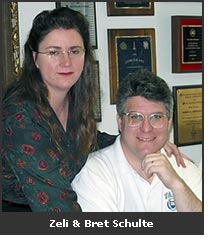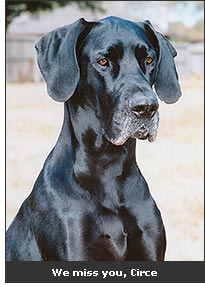|
— THE
TWO FACES OF HEMANGIOSARCOMA —
As Experienced by Zeli and Bret Schulte
Introduction | Part
1 | Part 2 | Part
3 | Conclusion
March 19, 2007 — Several weeks ago
we talked about hemangiosarcoma,
a deadly form of cancer that most commonly affects large dogs,
including the Great Dane. Hemangiosarcoma
is a rapidly growing, rapidly metastasizing cancer that originates in
blood vessels. These cancerous growths are usually found in a victim's spleen
or heart, often with involvement of the liver, lungs or brain. Blood vessels
feed into tumor site(s), which become engorged with blood. The tumors
eventually rupture, causing the victim to bleed to death, often with very little
warning.
Circe and Grendel
Zeli and Bret Schulte
recently lost their beloved Grendel to hemangiosarcoma. Unfortunately it wasn't
their first experience with this dreadful disease. Two and a half years earlier
they lost Circe, another beloved Dane, to the same thing. In Circe's case the
cancer was undiagnosed; her death was completely unexpected. In Grendel's
case, the cancer was detected in an advanced state. The Schulte's — along
with Grendel — put up a strong fight against the disease but it was
a battle nobody could win. Grendel lived just 30 days. She died on January 31,
2007, after sharing nine and a half happy years with Zeli and Bret.
Zeli has graciously
offered to share her experiences with hemangiosarcoma. She will provide us with
personal insights into its symptoms, prognosis, treatment options, along with
some practical and emotional considerations. She writes:
HEMANGIOSARCOMA: Our
Personal Journey
 In
my experience with Great Danes, I have seen the two faces of hemangiosarcoma — the
sudden loss and the fight for life. I lost two bitches to this deadly cancer — both
shortly after they turned nine. Circe and Grendel had received geriatric workups
twice a year after the age of six and both had been spayed relatively late in
life, when they were almost eight years old. Their biannual geriatric exams included
a routine physical examination along with blood and urine tests. Circe received
a glowing bill of health just a month before she died. Grendel, during her final
year of life, presented slightly elevated liver enzymes, however the numbers
were low enough that our vet was unconcerned. In fact, Grendel's liver enzymes
tested in the normal range just two weeks before she was diagnosed with hemangiosarcoma
in her liver and spleen. Despite our best efforts and regular vet check-ups,
nobody detected Grendel's hemangiosarcoma until it reached the advanced stage. In
my experience with Great Danes, I have seen the two faces of hemangiosarcoma — the
sudden loss and the fight for life. I lost two bitches to this deadly cancer — both
shortly after they turned nine. Circe and Grendel had received geriatric workups
twice a year after the age of six and both had been spayed relatively late in
life, when they were almost eight years old. Their biannual geriatric exams included
a routine physical examination along with blood and urine tests. Circe received
a glowing bill of health just a month before she died. Grendel, during her final
year of life, presented slightly elevated liver enzymes, however the numbers
were low enough that our vet was unconcerned. In fact, Grendel's liver enzymes
tested in the normal range just two weeks before she was diagnosed with hemangiosarcoma
in her liver and spleen. Despite our best efforts and regular vet check-ups,
nobody detected Grendel's hemangiosarcoma until it reached the advanced stage.
I've since learned that
in many cases dogs afflicted with hemangiosarcoma die quite suddenly with no
outward clinical signs. This is why hemangiosarcoma is known as "the silent killer." Hemangiosarcoma
is difficult to diagnose on physical examination and very easy to miss on radiographs/xrays.
Ultrasound is considered more effective than radiographs for revealing hemangiosarcoma,
but it often fails to reveal the tumors. MRI (magnetic resonance imaging)
is the preferred tool for detecting the presence of hemangiosarcoma. However,
few vet clinics have an MRI machine on site, and by the time an MRI is deemed
necessary, the disease is usually at a very advanced stage.
CIRCE'S STORY — A
Sudden Loss
 On
July 20, 2004, about two weeks after she turned nine, Circe had a bout of diarrhea
in the house — something that had not happened since she was
a puppy. I thought this was unusual, but then again, our male Great Dane, Grimm,
had some stomach trouble the week before so I assumed Circe probably caught something
from him. After cleaning the mess I did not notice anything strange about the
stool so I thought I would give it a day or two to resolve. If it did not, I
would take Circe to the vet. On
July 20, 2004, about two weeks after she turned nine, Circe had a bout of diarrhea
in the house — something that had not happened since she was
a puppy. I thought this was unusual, but then again, our male Great Dane, Grimm,
had some stomach trouble the week before so I assumed Circe probably caught something
from him. After cleaning the mess I did not notice anything strange about the
stool so I thought I would give it a day or two to resolve. If it did not, I
would take Circe to the vet.
That night I took the dogs on their last walk before going to bed. Ten minutes
after we got home Circe vomited. Once again, this was unusual because Circe rarely
vomited, but I chalked this up to the stomach bug. After quickly cleaning up
the mess, I called for Circe. She never came. I went outside looking for her
and finally found her under a bush with her head hanging down. When I tried to
get her to her feet, she collapsed. I called my husband, Bret, and he carried
Circe inside. She seemed very tired. I checked her abdomen because I suspected
bloat or torsion, but her abdomen was not distended or tight. Then Circe had
an uncontrolled bowel movement on her bed. We rushed her to the emergency vet
clinic which was, thankfully, only ten minutes away.
 At the Emergency Clinic At the Emergency Clinic
Arriving at the ER, we told the staff that we suspected bloat or torsion.
X-rays were taken immediately. They revealed nothing, other then confirming the
abscence of bloat and/or torsion. The ER vet told us she believed Circe was suffering
from heat exhaustion or possibly a stomach virus. Bret and I were puzzled by
her suggestion that heat exhaustion was responsible for Circe's condition. Even
though it was mid-summer in Houston, Texas, Circe lived indoors with air conditioning
and our walk that evening had been short and breezy. We were further informed
that Circe had started passing bloody diarrhea. This seemed particularly odd
because Circe's uncontrolled bowel movement at the house had been firm with no
signs of blood. When questioned, the ER vet attributed the bloody diarrhea to
a stomach virus. She advised us to make an appointment with our regular vet
the following morning. We took the ER vet at her word when she said that Circe
was stable enough to return home. In fact, Circe had actually perked up a little
at the ER. She wandered from where the staff had placed her on the floor and
tried to climb up onto the vet's on-call bed. The nurse caught Circe just as
she was putting one paw on the bed to climb up.
Home Again
After we got home,
Circe became increasingly lethargic. We attributed this to the lengthy ER visit,
the time of night, and the suspected stomach virus. I did not notice any bloody
diarrhea at home. Nonetheless, I decided to sleep with Circe in the living room
close to the front door just in case she needed to rush outside during the night.
We set the alarm for 7am so that we could call our vet and get the earliest possible
appointment for Circe.
 I was still asleep when Bret
checked on Circe and then woke me up to tell me that she was gone. Circe had
bled out (rectally) during the night. I was still asleep when Bret
checked on Circe and then woke me up to tell me that she was gone. Circe had
bled out (rectally) during the night.
Unbearable Loss
We were in shock.
We called our treating vet and described what happened. Our vet told us that
the cause of death was most likely due to a ruptured hemangiosarcoma tumor. We
were devastated —
angry with ourselves for not taking Circe to another ER for a second opinion,
and feeling guilty that we accepted the ER vet's
word that Circe was stable enough to return home even though we felt "heat
exhaustion" was a flagrant misdiagnosis. To this day, I believe Circe could
have been saved that night if we had been more assertive at the ER. She was a
very healthy 9-year-old and she was a survivor, having already made
it through a misdiagnosed pyometra and a delicate spinal surgery, both less than
two years earlier. I vowed that Circe would not die in vain and that the next
time we would be more aggressive with regard to diagnosis and treatment.
©2002-2008
by Ginnie Saunders. All rights are reserved. No part of this web
site
may be reproduced or transmitted in any form or by any means —
electronic or mechanical, including photocopying, recording, or by
any information storage or retrieval system — without written
permission from Ginnie
Saunders. To learn more about copyright issues on the web,
visit the Web Law
FAQ.
Ginnie.com, Inc.
PO Box 50314
Columbia, SC 29250
(803) 783-3169
www.ginnie.com
|


|

![]()



 In
my experience with Great Danes, I have seen the two faces of hemangiosarcoma — the
sudden loss and the fight for life. I lost two bitches to this deadly cancer — both
shortly after they turned nine. Circe and Grendel had received geriatric workups
twice a year after the age of six and both had been spayed relatively late in
life, when they were almost eight years old. Their biannual geriatric exams included
a routine physical examination along with blood and urine tests. Circe received
a glowing bill of health just a month before she died. Grendel, during her final
year of life, presented slightly elevated liver enzymes, however the numbers
were low enough that our vet was unconcerned. In fact, Grendel's liver enzymes
tested in the normal range just two weeks before she was diagnosed with hemangiosarcoma
in her liver and spleen. Despite our best efforts and regular vet check-ups,
nobody detected Grendel's hemangiosarcoma until it reached the advanced stage.
In
my experience with Great Danes, I have seen the two faces of hemangiosarcoma — the
sudden loss and the fight for life. I lost two bitches to this deadly cancer — both
shortly after they turned nine. Circe and Grendel had received geriatric workups
twice a year after the age of six and both had been spayed relatively late in
life, when they were almost eight years old. Their biannual geriatric exams included
a routine physical examination along with blood and urine tests. Circe received
a glowing bill of health just a month before she died. Grendel, during her final
year of life, presented slightly elevated liver enzymes, however the numbers
were low enough that our vet was unconcerned. In fact, Grendel's liver enzymes
tested in the normal range just two weeks before she was diagnosed with hemangiosarcoma
in her liver and spleen. Despite our best efforts and regular vet check-ups,
nobody detected Grendel's hemangiosarcoma until it reached the advanced stage.  On
July 20, 2004, about two weeks after she turned nine, Circe had a bout of diarrhea
in the house — something that had not happened since she was
a puppy. I thought this was unusual, but then again, our male Great Dane, Grimm,
had some stomach trouble the week before so I assumed Circe probably caught something
from him. After cleaning the mess I did not notice anything strange about the
stool so I thought I would give it a day or two to resolve. If it did not, I
would take Circe to the vet.
On
July 20, 2004, about two weeks after she turned nine, Circe had a bout of diarrhea
in the house — something that had not happened since she was
a puppy. I thought this was unusual, but then again, our male Great Dane, Grimm,
had some stomach trouble the week before so I assumed Circe probably caught something
from him. After cleaning the mess I did not notice anything strange about the
stool so I thought I would give it a day or two to resolve. If it did not, I
would take Circe to the vet. At the Emergency Clinic
At the Emergency Clinic I was still asleep when Bret
checked on Circe and then woke me up to tell me that she was gone. Circe had
bled out (rectally) during the night.
I was still asleep when Bret
checked on Circe and then woke me up to tell me that she was gone. Circe had
bled out (rectally) during the night. 